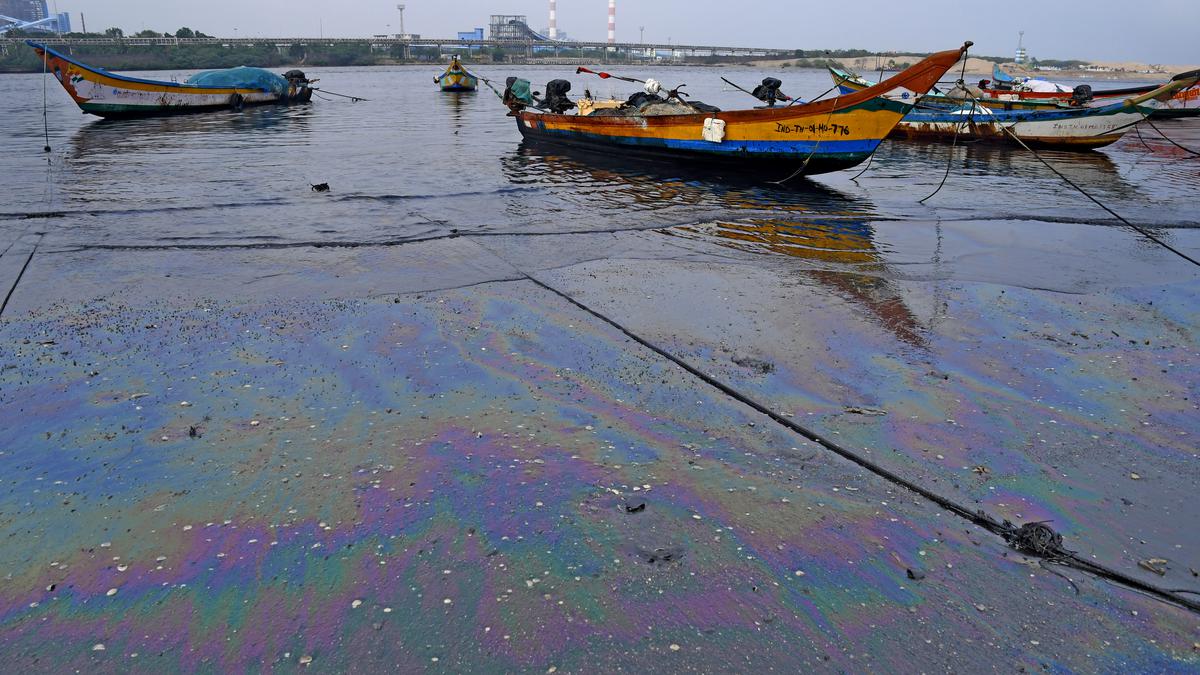
An oil spill in an ignored wetland in Tamil Nadu Premium
The Hindu
Even as oil from the Chennai Petroleum Corporation Limited refinery flooded houses and entered the Buckingham Canal and the Kosasthalaiyar river, which empties into the Bay of Bengal, at Ennore, the Tamil Nadu Pollution Control Board underplayed the extent of the ecological disaster.
On December 3-4, Cyclone Michaung, which lingered 100 km off the coast of Chennai for about 16 hours, brought heavy rainfall to the city. It forced the Tamil Nadu government to not only deal with the problem of heavy flooding, but also turn its attention to the wetlands of the heavily industrialised Ennore-Manali region in the northern part of the city where oil had spilled over from the premises of a public sector refinery.
Even as oil from the Chennai Petroleum Corporation Limited (CPCL) refinery flooded houses and entered the Buckingham Canal and the Kosasthalaiyar river, which empties into the Bay of Bengal, at Ennore, the Tamil Nadu Pollution Control Board underplayed the extent of the ecological disaster. Since the spill occurred in inland waters, the Indian Coast Guard could confirm that the oil had entered the sea only through an aerial assessment.
The State government began to act only eight days after the spillage and after it was nudged by the National Green Tribunal (NGT). The government’s 20-member oil spill crisis management committee, headed by the Chief Secretary, inspected the mouth of the river, or Ennore Creek, and directed the CPCL to compensate for the damages caused to the environment and the fisher folk, and ramp up remediation.
The initial work was not only delayed but also haphazard. Without an approved standard operating procedure in place and for reasons that are unclear, the Tamil Nadu State Disaster Management Authority and district authorities, who, as per the draft ‘Tamil Nadu State Oil Disaster Contingency Plan’, are the nodal agency and the on-scene commander, respectively, took a back seat.
The Department of Environment, Climate Change and Forests set up a coordination centre at Ennore. Along with the CPCL, the Department deployed one oil skimmer and 200 fishermen with their boats from the hamlets of Ennore to remove the oil. As of December 16, 300 additional workers from four sea-cleaning agencies were brought in along with a fleet of machinery comprising five gully suckers, four skimmers, poclains and tippers. Over 50 tonnes of oil-laden sludge have been removed from Kosasthalaiyar so far.
The Department has said that remediation is expected to be completed by December 19. However, it would be unwise to rush the clean up as, in addition to the 11-kilometre stretch from the CPCL plant to Ennore Creek, oil has spread further south till the Kasimedu harbour and up north to the Pulicat backwaters, a fishing ground and also a biodiversity hotspot for thousands of migratory birds.
State government officials and the CPCL said that the incident was “unprecedented” and that they were “caught unawares”. However, in 2017, two cargo ships carrying oil collided near Kamaraj Port in Ennore, significantly affecting the fisherfolk and their livelihoods. Besides, there are 17 highly polluting industries in Manali of which nine are petrochemical, and the residents of the region have been flagging pollution concerns for years.













